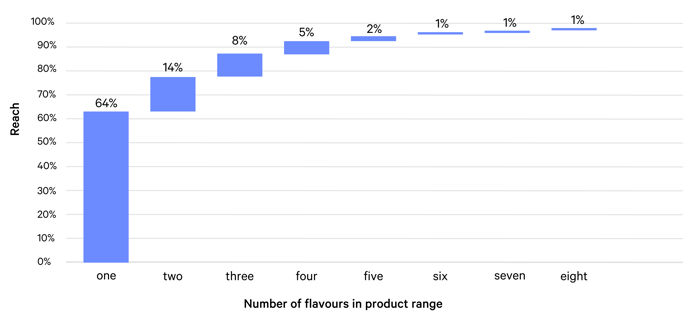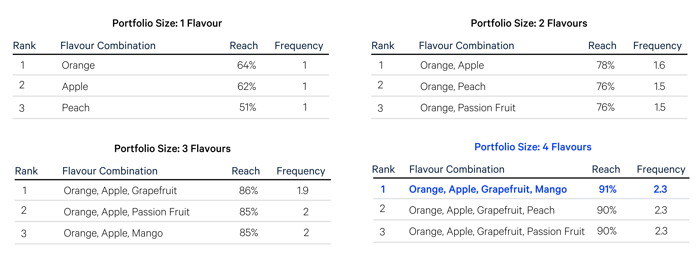Identify unknown potential with the TURF Analysis
Appinio Research · 20.10.2022 · 11min read

Content
Discovering which product will appeal to the greatest number of customers can be a challenge for any company.
Enter TURF analysis, the Total Unduplicated Reach and Frequency method, which can help businesses identify the ideal product portfolio or marketing mix that will reach the broadest target group. This powerful market research tool provides valuable insights that enable companies to make data-driven decisions and maximize their reach and impact in the market.
In this article, we'll dive into the ins and outs of TURF analysis and show you how to apply it to your business strategy.
What is the TURF Analysis?
TURF Analysis is a powerful way to analyze existing data, originally developed in media research to determine the reach of advertising campaigns.
Using TURF, researchers can identify the optimal combination of channels to reach each person in the target audience at least once (Unduplicated Reach) and how frequently they are exposed to the product or campaign (Frequency).
Initially, the focus of TURF analysis was to increase the efficiency of campaigns without increasing the budget.
However, this method can now be applied to many other areas beyond media planning, such as assortment planning, product portfolio development, and optimization.
By analyzing the metrics of reach and frequency for an entire portfolio, TURF analysis helps answer two critical questions:
- Which products should be included in my portfolio to reach the largest possible target audience? (Reach)
- On average, how many products will the target audience purchase from my product portfolio? (Frequency)
.png?width=457&height=304&name=UK_TURF%20(1).png)
Want to dive deeper and maximize your market reach? Then watch our webinar recording with research expert Houssein! Identify the perfect product mix optimize messaging, and make data-driven decisions for strategic success.
Use cases for the TURF method
The TURF Analysis, originally used for media research and planning, is now applied to various fields such as product planning, claim testing, and advertising placement.
This is because the TURF components of Total Unduplicated Reach and Frequency are critical in these areas.
Additionally, TURF considers limiting factors such as budget and limited space, such as on supermarket shelves or packaging.
TURF Analysis is a versatile tool that can answer a range of questions, including:
- Which ice cream varieties should I offer to reach the most customers while providing each person with at least one preferred variety?
- Can I expand my fruit juice range to attract new customers, and will the costs of launching a new product be justified by the additional revenue?
- Which product USP should be emphasized on the packaging to appeal to the most customers?
- Which magazines should I choose for print ads to reach the most customers with a limited budget?
- Will adding oat milk to a café's product range attract new customers or only cater to the existing customer base?
With applications in assortment management, marketing, activation, category management, and advertisement and media planning, TURF Analysis can identify potential and optimize resources for maximum efficiency.
How to use the TURF method
Conducting a TURF Analysis is a simple process that can be integrated into various survey types, including Multiple Choice or Matrix questions in a conjoint or MaxDiff analysis.
There is no need for special question or survey methodology to conduct a TURF Analysis.
More information on the different question types can be found in our survey guide.
TURF method example
To illustrate the TURF Analysis, let's consider an example of fruit juices.
The goal is to expand the product range and attract new customers while ensuring cost coverage.
To achieve this, it's essential to identify the flavours that provide the highest added value.
A Multiple Choice question can be used to identify the most popular flavors among consumers. All available flavors are listed and ranked in order of popularity for evaluation.
.png?width=700&name=TURF_MC%20Basics%20EN%20(1).png)
The Multiple Choice results for the fruit juice example may seem clear, as the flavours of orange, apple, peach, and passion fruit were identified as the most popular choices.
However, since participants can choose multiple options, there could be overlap between groups. For instance, the 64% of participants who prefer orange juice may also prefer the other three flavours. Thus, offering these four flavours alone may only reach 64% of the target group.
To expand the target group, it may be necessary to add a less popular flavour to the range.
This is where the TURF Analysis comes in handy, as it can determine which flavour combination can reach the most customers.
By using the TURF method, it is possible to identify which product portfolio combination has the highest unduplicated reach and frequency, thus maximizing the efficiency of the product portfolio.
Evaluating the TURF Analysis results with Appinio
After conducting a TURF analysis, the results are presented in a waterfall diagram which illustrates the percentage of customers that can be reached with additional products.
In the case of the fruit juice example, the analysis showed that offering four different flavors would reach 91% of all customers, with each customer on average liking 2.3 of the varieties offered.

However, the optimal portfolio size must take into account the costs associated with launching a new product.
Adding a fifth variety may only reach an additional 2% of customers, but may not be economically viable as it would not generate enough revenue to cover for the product launch costs.
Now that the optimal portfolio size has been determined, which flavors should be offered?

These tables show the optimal variety combination depending on the portfolio size.
In the case of the fruit juice example, the recommended combination is orange, apple, grapefruit and mango (highlighted in blue on the table).
The table also includes the values for Reach and Frequency.
With this portfolio, 91% of all customers can be reached. Of these, on average everyone likes 2.3 of the varieties offered (Frequency) and will most likely buy several.
Advantages and disadvantages
TURF Analysis has many advantages that make it a popular method for determining sales potential.
Advantages
- The method is flexible and can be applied to a wide range of topics in assortment, category, and media planning.
- It provides direct calculation of two metrics: frequency (how many products does a customer like on average?) and reach (which products really reach new customers?), making it a useful tool for estimating both sales potential and purchase behavior.
- TURF Analysis can also help identify cannibalization of products, allowing businesses to optimize their product portfolios.
- The method is easy to use, and no special question or survey methodology needs to be considered to conduct a TURF Analysis.
Disadvantages
While TURF analysis can be a useful tool for identifying the optimal combination of products or services to reach a target audience, there are several limitations to consider:- Assumptions about independence
TURF analysis assumes that the products or services being analyzed are independent of each other, meaning that the introduction of one product or service does not affect the reach or frequency of the others. However, this may not always be the case in reality. - Limited view of consumer behavior
TURF analysis only considers reach and frequency, and does not take into account other factors that may influence consumer behavior, such as price, quality, brand loyalty, and product features. - Assumes equal importance of all products
TURF analysis assumes that all products or services being analyzed are equally important to consumers, which may not be true in all cases. - Small sample sizes
It requires a large sample size to ensure accuracy, which may be difficult or expensive to obtain in certain situations. - Does not account for external factors
It does not take into account external factors such as market competition, economic conditions, and cultural differences, which may influence consumer behavior and product adoption.
Conclusion for TURF-Analysis
By using TURF Analysis, businesses can obtain valuable and granular insights into the preferences of their target customers, which can inform decisions regarding the optimal product portfolio, color combinations, media mix, and sales locations.
The method's flexibility is a major advantage, as it can be applied in conjunction with different types of surveys, including MaxDiff and conjoint analysis, as long as a multiple-choice question is included.
This makes TURF Analysis an effective and efficient tool for businesses looking to expand their offerings and reach new customers while maintaining cost-effectiveness.
TURF Analysis explained
-
To conduct a TURF analysis, you need to identify the most desirable combination of product features by analyzing the frequency of their occurrence in a sample of respondents.
-
To measure TURF quality, researchers will typically use statistical software to perform a TURF analysis, which involves analyzing different combinations of products or services to determine which combination provides the greatest reach and frequency with the least amount of overlap. The Appinio Platform will do all of it for you.
-
TURF analysis allows you to take into account the complex combination of choices that people make when selecting products or services.
-
The limitations of TURF analysis include its inability to consider interactions between product features and the assumption that customers make rational choices without considering external factors such as price or brand loyalty.
-
To run a TURF analysis in Excel, you can use specialized software add-ins, such as XLSTAT or Q Research Software, which offer TURF analysis as a feature. Appinio offers this functionality for clients without any set-up work for you.
Are you interested in conducting a TURF Analysis?
In our dashboard, you will find questionnaire templates that you can customize and get the insights you need to bring your brand to the next level.
Get facts and figures 🧠
Want to see more data insights? Our free reports are just the right thing for you!


